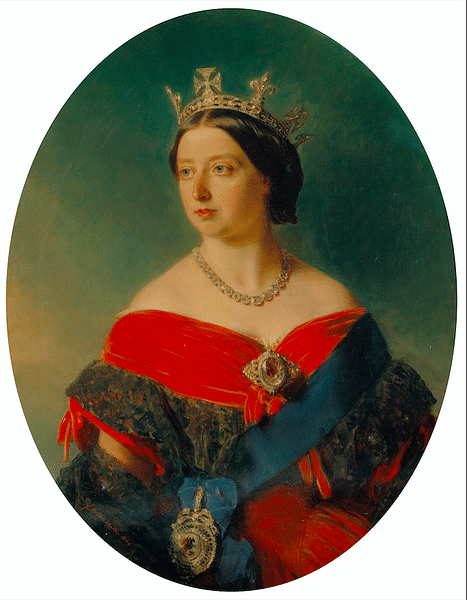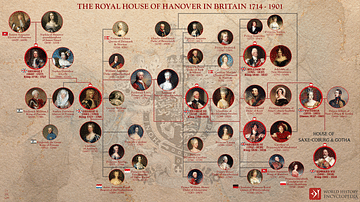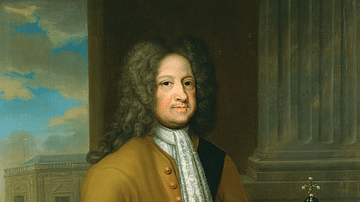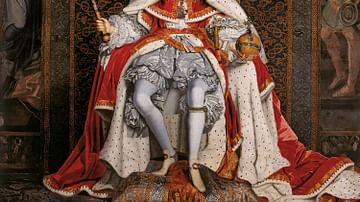
Queen Victoria of Great Britain (r. 1837-1901) was one of the most loved of all Britain's monarchs. Her longevity, devotion to her role as figurehead of an empire, and recovery from the death of her beloved husband Prince Albert won her a unique status as the ever-present symbol of 19th-century Britain, an era of tremendous political, industrial, and social changes.
The last of the British Hanoverian monarchs, Victoria reigned for 63 years. She weathered the storms of life – outliving three of her children – and survived assassination attempts, family scandals, gossip over her relationship with her beloved servant John Brown, and reformers who wanted to topple the Crown. Britain and the British Empire would never be quite as great again when Victoria died in January 1901. Queen Victoria was succeeded by her eldest son who became Edward VII of Great Britain (r. 1901-1910).
The Hanoverians & Succession
The royal house of Hanover had taken over the British throne in 1714 following the death of Queen Anne of Great Britain (r. 1702-1714), who had no children. The Hanoverians were also electors of Hanover, a small principality in Germany, and so both George I of Great Britain (r. 1714-1727) and George II of Great Britain (r. 1727-1760) were very much Germans ruling in Britain. George III of Great Britain was the first Hanoverian to be born in Britain and to speak English as his first language; he was succeeded by two of his sons: George IV of Great Britain (r. 1820-1830) and William IV of Great Britain (r. 1830-1837).
William IV died of cirrhosis of the liver and pneumonia on 20 June 1837, but he had no surviving legitimate children. As planned, the British Crown passed to his niece Victoria, daughter of George III's late fourth-eldest son, Edward Augustus, Duke of Kent (1766-1820) and Marie Louise Victoria of Saxe-Coburg-Saalfeld (later to become Saxe-Coburg-Gotha). This niece became Queen Victoria of the United Kingdom of Great Britain and Ireland.

Alexandrina Victoria was born in Kensington Palace on 24 May 1819. She had no memories of her father who died in 1820 and her mother, therefore, grew in importance, as did her mother's younger brother Prince Leopold who became King of the Belgians in 1831. A third key figure in the young Victoria's childhood was her German governess Baroness Louise Lehzen (1784-1870). Victoria's education was limited to that of a lady of the period and was not that of a future monarch, but Victoria was intelligent and keen to learn. The celebrated royal biographer C. Woodham-Smith gives the following summary of Victoria's character, abilities, and weaknesses:
She was not an easy character, possessing remarkable qualities allied with emotions so intense as, at times, to reach violence ... She spoke and wrote several languages with considerable fluency. Physically she was strong ... She was obstinate – obstinacy was her chief failing – but she could be converted and when she gave way she did so with a good grace. Honesty, generosity, loyalty were her good qualities; she never bore malice and it was rare to come into close contact with her without being inspired with devotion.
(431)
Victoria's childhood had been a lonely and relatively impoverished one (considering her future position) and was led primarily in apartments in Kensington Palace. She had not been allowed to cavort with her cousins, the crowd of illegitimate children of William IV that went under the invented family name of FitzClarence. Victoria's only real company were her 132 dolls. This sheltered life, where Victoria "longed sadly for some gaiety" (diary entry quoted in Cannon, 337) all changed with her succession in 1837.
Victoria had just turned 18 when she became queen. The succession meant that the British and Hanover titles were split, as no female was permitted to rule the principality if there was a male heir, no matter how remote. Accordingly, George III's fifth son Ernest Augustus, Duke of Cumberland and Teviotdale (1771-1851), became the new King of Hanover. Victoria was the last of the British Hanoverians as her children were classed as part of her husband Prince Albert's' family of Saxe-Coburg-Gotha (which was later renamed Windsor).

Prince Albert & Personal Life
The magnificent coronation was held in Westminster Abbey on 28 June 1838. To guide her in her political role, Victoria had Lord Melbourne, prime minister in 1834 and from 1835 to 1841. The queen called her first prime minister "Lord M". Small in stature (4ft 11 in / 1.5 m tall) and with large blue eyes and a rather small mouth, the young queen was independent-minded and determined to take on fully her role as a constitutional monarch. The monarchy was by now severely limited in terms of political power but remained an important figurehead and point of intervention when the politicians could not agree. As Walter Bagehot (1826-1877) noted in his famous work of 1867, The English Constitution, Victoria, in regard to government, retained "the right to be consulted, the right to encourage, and the right to warn" (Cavendish, 412). Victoria began her reign favouring the Whig party, but Albert's influence ensured she soon rose above party politics. As Whig and Tory prime ministers came and went during her long reign, the queen's extensive experience of state matters made her a valuable sounding board and source of wisdom.
On 10 February 1840, Victoria married her cousin Albert of Saxe-Coburg-Gotha (1819-1861) after a one-year engagement. The wedding took place at St. James' Palace. The union had been championed by Albert's uncle King Leopold, but Victoria found herself greatly attracted to the prince who she described as "beautiful" (written in italics and underlined for emphasis in her diary). Unusually for monarchs, Victoria and Albert were of the same age, but as sovereign, the protocol required Victoria to ask Albert to marry her and not vice-versa. He agreed and was eventually given the title Albert, Prince Consort as Victoria remained the outright sovereign. Albert, nevertheless, read Victoria's state papers and gave her advice when required; he described himself as "the private secretary of the sovereign and her permanent minister" (402).
The royal couple had nine children: five girls and four boys, the eldest of whom, Albert Edward (b. 1841), known as 'Bertie', became Prince of Wales. Victoria, despite her experience, always feared the risks of childbirth and the forced absences from her role as monarch. Pregnancy, she said, was the "shadow-side of marriage" (Phillips, 217). The royal family deliberately set out to provide the nation with a role model of respectability and family duty; this was in stark contrast to the previous Hanoverian monarchs. 'Bertie' proved a disappointment in this department and had a highly unsuitable affair with the courtesan Nellie Clifden just when his parents were trying to arrange his marriage to Princess Alexandra of Denmark (a union which did go through in 1863).

Facing Radicalism
Victoria's succession was not looked upon favourably by everyone. Radicals and republicans were in the minority, but their views manifested themselves in an assassination attempt on the queen whilst riding in a carriage in London. On 10 June 1840, an 18-year-old took two pistol shots at the royal couple but missed with both. On 30 May 1842, a second assassin – although bizarrely his gun was not loaded – accosted the queen in Pall Mall and was apprehended with Victoria unharmed. Later that summer, on 3 July, yet another young would-be-assassin took a potshot at the queen, but he had not loaded his gun well, and he, too, missed his target. On 19 May 1849, an Irish assassin shot at the queen as she drove home in her carriage, but he also had not properly loaded his gun. There would be a few more attempted attacks on the queen, one madman even managing to strike Victoria with a stick that left her badly bruised in the face. Through it all, Victoria seemed to live a charmed life.
The period was a testing one for many monarchs in Europe with revolutions attempting to depose sovereigns, sometimes with success, as happened in France. It can be considered one of Victoria's many achievements not only to have weathered the radical storm but to actually have increased the popularity of the monarchy through her reign.
Tragedy & Withdrawal
The queen suffered her greatest tragedy on 14 December 1861 when Albert died of typhoid fever (or perhaps really the final phases of stomach or bowel cancer). The Prince Consort, already ill with stomach pains and tired out worrying about 'Bertie's' escapades, had got caught in the rain out visiting a new architectural project, and his condition deteriorated from there. He was just 42 years of age. Perhaps the queen never really recovered from her loss; she once wrote, simply, and encompassing all that Albert had meant to her in just four words: "He was my life" (Phillips, 217). In a sense, for the next few years, Victoria herself died. The queen could not bring herself to attend Albert's funeral, and she wore black for the remaining second half of her long life. The queen made sure that Albert and the causes he had championed were not forgotten. The fallen prince was commemorated in countless public buildings, perhaps most notably with the Royal Albert Hall in London, first opened on 8 April 1871.

Until the early 1870s, the queen withdrew from public life and spent a great deal of time at Windsor Castle or Balmoral, her and Albert's favourite royal residence and one which had been designed by the Prince Consort. The queen conducted her role in government via correspondence. Blaming 'Bertie' for his role in his father's demise, Victoria restricted his public royal roles as best she could so that the Prince of Wales and heir was, at least in official circles if not the pleasure haunts, an absent figure, too. Unimpressed with her son, Victoria described the prince as having "a small, empty brain" (Cannon, 345). This royal vacuum gave ammunition to republicans who were calling for the abolition of a monarchy that could not perform its already limited role.
The mystery surrounding the hidden queen, who became known as the 'widow of Windsor', led to unkind rumours such as an unsuitable relationship existed with her colourful and plain-speaking Scottish servant John Brown (1826-1883). The queen even gained the nickname 'Mrs Brown'. By the time Benjamin Disraeli (1804-1881) took office for a second time (1874-80) and established himself as Victoria's favourite prime minister, the queen was slowly returning to a more public role as the head of state. The queen also travelled abroad for rest, notably to Biarritz and the Côte d'Azur in France, greatly helping these places become fashionable resorts for Europe's well-to-do.

Victoria was unfortunate to outlive three of her children. Princess Alice (b. 1843) died of diphtheria on 14 December 1878, in a cruel coincidence, the same date as Albert's death. In March 1884, the queen's youngest son Leopold, Duke of Albany (b. 1853) died after a bad fall. Leopold had suffered from haemophilia and possibly also epilepsy. In July 1900, Prince Alfred, Duke of Saxe-Coburg and Gotha (b. 1844) died of throat cancer aged 55.
Empire & Wars
Britain was involved in the Crimean War (1853-6) where Britain, France, the Ottoman Empire and others joined to defeat Russia. Victoria had opposed the war and personally visited wounded combatants being treated in hospitals back home. The conflict saw the creation of the Victoria Cross (1856), the highest British military award, and it was the queen's decision to have the words "for valour" added to the front of the medal.
Through the 19th century, the British Empire became the largest the world had ever seen, and it ranged from massive territories like Canada, India, and Australia to small outposts like Barbados, Gibraltar, Aden, Hong Kong, and Fiji. Most of the eastern half of Africa was under British rule in an almost uninterrupted line from Cairo to Cape Town.
Britain's empire-building was relentless, but there were some serious setbacks along the way. India was almost lost during the Sepoy Mutiny of 1857-8, but, regaining control, the East India Company possessions were taken over by the British government. Victoria was made Empress of India on 1 June 1877. In the 1879 Anglo-Zulu War, almost an entire British army was destroyed at the Battle of Isandlwana. In 1885, the great military hero General Gordon was killed defending Khartoum and its residents against the self-proclaimed Mahdi, Muhammad Ahmad. This disaster in the Sudan was an infamous episode of military and political dilly-dallying.
Most of the colonies had to be defended – against other powers and insurrections from local populations – and so there was a conflict somewhere in the empire in every single year of Victoria's reign. The empire was about wealth and resource extraction, and these usually came at the expense of the indigenous peoples. Many colonies were only too glad to gain their independence in the 20th century. Colonization had brutal consequences, but the records do show that Victoria did seem to take a genuine interest in her subjects, who totalled one-fifth of the world's population.
Other Reign Events
Victoria's reign witnessed an extraordinary series of innovations and social and economic changes, many of which were displayed in one form or another at the Great Exhibition of 1851, held in the Crystal Palace, a massive purpose-built hall of glass and cast iron. Prince Albert's pet project and triumph, over 6 million visitors marvelled not only at the weird and wonderful machines but thousands of exhibits from around the world, everything from the latest set of false teeth to the fabulous Koh-i-Noor diamond.
Britain's first national census was conducted in 1851, and it revealed that now more people lived in towns and cities than in the countryside. People moved around much more, too. By the end of the 19th century, Britons could travel around with much greater ease with the arrival of the railways, the motor car, and the London Underground. Life at home was more pleasant, too, with the invention of the electric light, gas fire, gramophone, and radio. People also became more connected thanks to the penny post system, and more people could write than ever before because free schools were made available to all from 1891. The 1867 Reform Act and its successor of 1884 both greatly increased the number of males who could participate in elections. In contrast to the progression in Britain's democracy, the new structure for Parliament (necessary after the great fire of 1834) was a riot of medieval and Tudor architecture. The queen officially opened the new building on 3 February 1852.
The royal family played its own role in changes of behaviour, for example, Victoria popularised the use of chloroform during child labour and Prince Albert ensured the German Christmas tree took over from the traditional mistletoe rings as the centre-piece of many a family home.

The influence of Victoria spread even further thanks to her 31 grandchildren. One grandson became the German emperor as Kaiser Wilhelm II (r. 1888-1918), one granddaughter became Alexandra Feodorovna, Tsarina of Russia (1894-1917), and five others became queens of European kingdoms. Victoria had certainly left her mark both in Britain and abroad, so much so, she was known towards the end of her life as the 'matriarch of Europe'.
Death & Successor
The success of the British Empire and her longevity as a calm rock in the sweeping seas of change of the 19th century greatly helped boost Victoria's popularity which had waned somewhat during her mourning period for Albert. The esteem with which she was held in the public's gaze was best seen in the celebrations of Victoria's Golden and Diamond Jubilees (1887 and 1897, respectively). After the latter celebration, on 22 June, the queen noted in her diary:
A never to be forgotten day. No one ever, I believe, has met with such an ovation as was given me ... The crowds were quite indescribable ... The cheering was quite deafening, and every face seemed to be filled with real joy.
(Phillips, 222)
Queen Victoria, suffering ill health and rheumatism in her final year, died shortly after a stroke at her holiday retreat, Osborne House on the Isle of Wight, on 22 January 1901. She was 82 years old. Inside her coffin, according to her wishes, was a veritable curiosity shop of mementoes: a lock of John Brown's hair, a dress embroidered by her daughter Alice, several photographs, some small figurines, and even a quantity of jewels. In her never-dying love for Albert, the queen was buried, too, with a cast of the Prince Consort's hand and his dressing gown. The late queen's face was covered with her wedding veil. Now, after 40 years of separation, Victoria was reunited with her husband, buried beside him in the Royal Mausoleum, Frogmore in Windsor Great Park.
The number of Victoria's British subjects had doubled during her reign, and few indeed could remember a time when she was not queen. The Victorian era was finally over. Next on the throne was Victoria's eldest son who became Edward VII of Great Britain and who ensured the pomp and spectacle of the monarchy returned in full.





